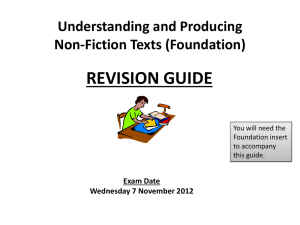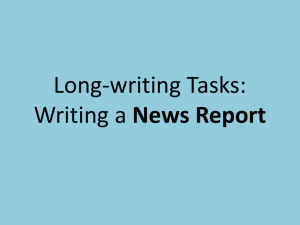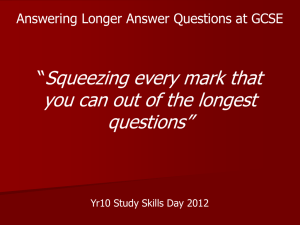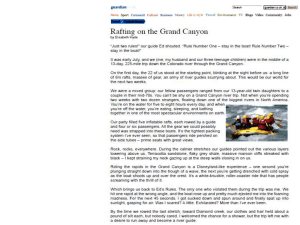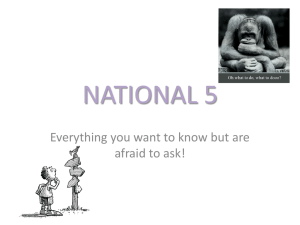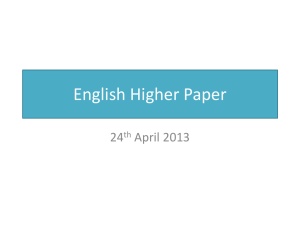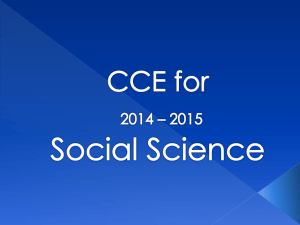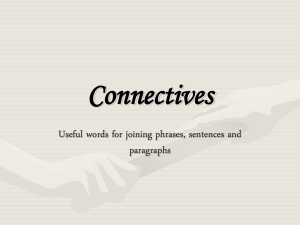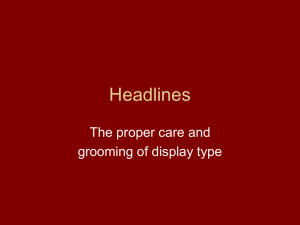Understanding and Producing Non-Fiction Texts
advertisement
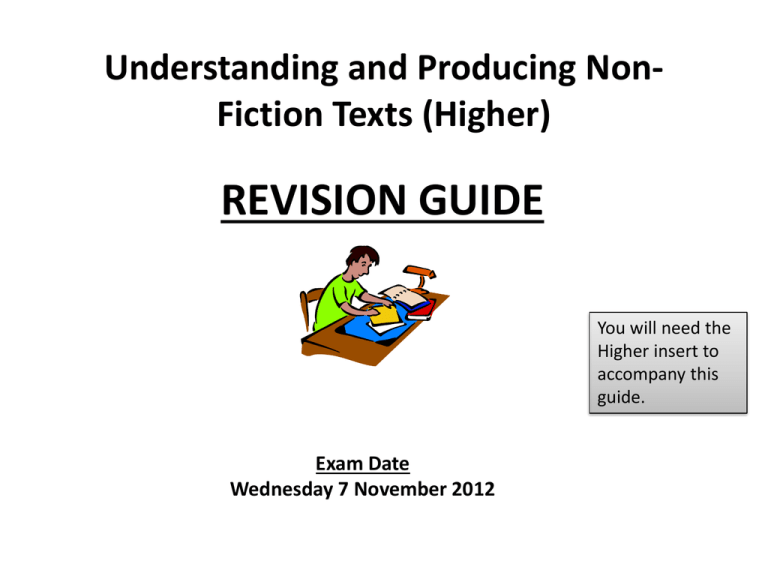
Understanding and Producing NonFiction Texts (Higher) REVISION GUIDE You will need the Higher insert to accompany this guide. Exam Date Wednesday 7 November 2012 Section A: Reading You will... •Read 3 non-fiction texts (sources 1, 2, and 3) •Answer 4 Questions. •Spend up to 1 hour and 10 minutes reading the texts and answering the questions. Exam Tip: • Read question 1, then read source 1 and then answer question 1. Read question 2, then read source 2 and then answer question 2. Read question 3, then read source 3 and then answer question 3. Read question 4, skim read both texts and the answer question 4. • Underline/annotate the texts as you read them. Question 1 • This question will always require you to respond to Source 1 only. • It is worth 8 marks. You should spend 10-12 minutes answering this question. • Aim to write about 5-8 different bits of information. • You must find and summarise information in your own words, using short quotations as evidence. This is not a language question, therefore you do not need to analyse the language. Complete the tasks on the next page... 1. Read source 1 of the insert. 2. Read the student’s response and comments to the question below. Begins by using the wording in the exam question Student’s own words What she has been doing Interprets meaning Read Source 1, the online travel article called Rafting on the Grand Canyon by Elisabeth Hyde. 1. What do you learn from Elisabeth Hyde’s article about where she has been and what she has been doing? (8 marks) In this article, we learn that Elisabeth Hyde and her family spent almost two weeks rafting down the “Colorado River through the Grand Canyon” in North America. Every day, she spent “five to eight” hours in the water in a 6m raft and when she wasn’t rafting down the river, she was “eating, sleeping or bathing” in the area surrounding the river. We also learn that she enjoyed being there as she described it as “one of the most spectacular environments on earth”. Where she has been Short embedded quotation Adding connective Additionally, we learn that Hyde and her family, were not there alone... 3. Continue and complete this response by adding an additional 4-6 points. Remember to... Use mostly you own words. Include short relevant quotations. Write about where Elisabeth Hyde has been and what she has been doing. Interpret meaning from the words Elisabeth Hyde has used. Question 2 • This question will always require you to respond to Source 2 only. • It is worth 8 marks. You should spend 10-12 minutes answering this question. • This question requires you to analyse and comment on the presentation features mentioned in the question (usually these will be the headline, sub-headline and images) and how they link to the main text (the rest of the article). • You should aim to make 2-3 comments for each presentation device. • Presentation features includes the language used in the headlines and sub-headlines. Look out for... •Individual words/phrases •Colour •Juxtaposition •Size •Number of image(s) •Detail within the image(s) Useful phrases The headline says “...” which suggests... The phrase “...” in the sub-headline implies... The size and colour of the .... in the image may make readers feel... This links to the idea in the main text that.... Complete the tasks on the next page... 1. Read source 2 of the insert. 2. Read the student’s response and comments to the question below. Now read Source 2, the article and the picture which goes with it called Fearsome Tyrannosaurus rex Sue may have died of a sore throat by Ian Sample. 2. Explain how the headline, sub-headline and picture are effective and Structured how they link with the text. (8 marks) response Effect on the reader Firstly, the headline is effective as the big bold letters will immediately draw in readers’ attention, however when they begin to read the headline, the contrast of the words “fearsome” and “died from a sore throat”, may intrigue the reader as the idea that such a “fearsome” dinosaur could have been killed by something as minor as a sore throat, may seem puzzling. Readers’ curiosity will be satisfied when they read the whole text and learn that the T-rex’s death was caused by a “common parasite that infects the mouth and throat” causing starvation. Comments on the presentation of the headline. Focuses on individual words within the headline Links the headline to the main text. Another effective presentation feature of this article is the subheadline... 3. Continue and complete this response by adding an additional 4-6 points. Remember to... Keep your response structured. Focus on the effect of individual words in the sub-headline. Make 2-3 comments on the sub-headline and 2-3 comments on the image. Explain how the sub-headline and the image links to the main text. Question 3 • This question will always require you to respond to Source 3 only. • This text will be literary non-fiction (eg. A biography extract) • It is worth 8 marks. You should spend 10-12 minutes answering this question. • You should aim to write 4-5 PEE paragraphs. • You must comment on the use of language to present ideas within the text. • Avoid vague responses. This is when you do not explain how or why. For example: “This makes the reader want to read on.” Useful phrases for PEE paragraphs: Point: One of the ways... Evidence: The is shown by the words “...” Explanation: This suggests... Readers may feel... Complete the tasks on the next page... 1. Read source 2 of the insert. 2. Read the student’s response and comments to the question below. Inferences/ interpretations of the language Now read Source 3, Everest The Hard Way, which is an extract from a nonfiction book. 3. Explain which parts of Pete Boardman’s story of the return to Camp 6 you find tense and exciting. (8 marks) On of the parts the story which is particularly tense is when Pete is waiting for his companion, Mick to arrive. Pete says that they will wait “ten minutes more” which enables him to “shift some of the responsibility to the watch”. This suggests that they are getting impatient of waiting (probably for fear of their own safety) and rather than making the decision themselves to leave Mick behind, they make time decide for Structured them. This is a tense moment for readers as they may begin to wonder response. where Mick is? Will he return to the camp on time and, significantly, is he still alive? Another tense part of the story... Short, relevant quotation to support point Explains how tension is created. Effect on the reader 3. Continue and complete this response by adding an additional 4-6 points. Remember to... Keep your response structured (sequencing/adding connectives). Use Point, Evidence and Explanation. Interpret meaning behind the language. Question 4 • This question will always require you to respond to two out of the three texts. • It is worth 16 marks. You should spend 20-22 minutes answering this question. • You must compare two texts by analysing the effects of the writer’s use of language. Key Language Devices Facts and statistics Opinions Emotive Anecdote Rhetorical questions Personal pronouns (you/we) Rule of three Imagery (similes etc) Formal/informal/slang Technical jargon Punctuation for effect Sentence structure Connectives Similarities: Similar to... Similarly... Just like... Equally... Differences: In contrast... However... Unlike.... On the other hand... Complete the tasks on the next page... 1. Read source 2 of the insert. 2. Read the student’s response and comments to the question below. Now you need to refer to Source 3, Everest The Hard Way and either Source 1 or Source 2. Compare the different ways in which language is used for effect in the two texts. Give some examples and analyse what the effects are. (16 marks) Both sources 1 and 2 immediately engage their reader's attention by starting with a short simple sentence. In source 1, “Just two rules!” leads readers to be intrigued to know what these rules are. The word “just” highlights the fact that there are only two rules , when readers would expect there to be many more rules as rafting is a dangerous activity, this implies that these two rules must be important. This is further emphasised by the exclamation mark which highlights the importance of these rules. The short sentence “A decision was needed” at the start of Source 3 has a similar effect of creating intrigue for the reader as they will want to know what decision will be made and why. Again emphasis is used here, but this time, by the word “needed” which suggests desperation. Point made is linked to the question Short, relevant quotation to support point Effect on the reader Developed analysis. Both texts use language to create a sense of excitement about their experience... 4. Continue and complete this response by adding an additional 4-6 similarities/differences. Remember to... Uses Keep your response structured (sequencing/adding connectives). comparison Use Point, Evidence and Explanation. connectives to Develop and analyse the effect of the language. signal Identify similarities and differences between both texts. comparison. Section B: Writing You will... •Respond to 2 Questions. 1. Short writing task (16 marks) 2. Long writing task (24 marks) •Spend up to 1 hour and 5 minutes planning, writing and checking your responses. •25 minutes on the short task. •35 minutes on the long task. Exam Tip: • Complete the long writing task first! If you run out of time, you will have gained more marks on this task than the short writing task. Explanation Persuade & Argue You will gain marks for your ability to engage your reader in a way that suits the purpose. Emotive language (Appealing to readers’ emotions eg. guilt) Anecdote (A brief account of the writer’s personal experience) Facts & statistics (True statements/ percentages etc) Opinions (A personal belief, often stated as fact) Rule of three Addressing readers directly (2nd person pronoun) (you, your) Hyperbole (Deliberate exaggeration for effect) Superlatives (Stating that something is the ‘greatest’ or the ‘worst’ etc.) Imperatives Instructions or demands eg. ‘stand up’ ‘go to the...’ Alliteration Eg. ‘Sea, surf and sun’ Flattery Repetition (Words or phrases repeated Rhetorical questions Quotations from experts Facts & statistics (True statements/ percentages etc) 6 Ws (who, what, where, when, why, how) Opinions (A personal belief) Anecdote (A brief account of the writer’s personal experience) Rhetorical questions Descriptions (adjectives, adverbs, smiles etc). Informal or formal? Humorous or serious? This will depend on who you are writing for (audience). You will gain marks for organisation and structure Topic Sentence (Possibly with an adding connective) In addition... Another point is... As well as... Evidence •Facts •Opinion(s) •Examples •Anecdote Explanation •Give reasons •Describe •Explain the impact of your evidence. Supporting Evidence (Possibly with an illustrating connective) Explanation (Possibly with an illustrating connective) Close Links back to the main idea in the topic sentence. Connectives For example... This is shown by... Such as... Connectives This means that... Significantly... Therefore... Consequently... As a result of this... You will gain marks for using a range of sentences and punctuation Use all of these types of sentences • • • • • • Minor sentence (1-2 words sentence) Complex sentence (remember to use comma(s)) A sentence containing a list Compound sentence Simple sentence Question ‘b’ A* A Inverted Commas - ... The Dash Ellipsis B C ; ( ) : Semicolon Brackets Colon D ! ? Exclamation Mark Question Mark TIP: Use an illustrating, emphasising or qualifying connective in every full paragraph. This will help you to develop and extend your paragraphs. (see p. 118 of your contact book) Section B: Writing 1. Primary purpose of Writing to Explain 5. Write a brief article for a website of your choice telling your readers about an interesting or unusual journey or travel experience you have had. Explain why it was memorable. (16 marks) This main purpose of this task is to explain. However, to make this writing lively and interesting to read, you will also need to describe the journey (the people involved and place(s) you visited) and possibly entertain your reader. Practice these skills by answering the writing question above. • Aim to write about 3 paragraphs. •Spend no longer than 25 minutes. •Plan before your write. Section B: Writing 2. Primary purpose of Writing to Argue (but could be persuade) 6. Your school or College is inviting entries for a writing competition. The topic is “Dangerous sports, activities and pastimes are selfish, often put others at risk and should be discouraged.” Write your entry arguing for or against this view. (24 marks) Practice these skills by answering the writing question above. • Aim to write about 4-5 paragraphs. •Spend no longer than 35 minutes. •Plan before your write. Spend 5 minutes... • Checking your writing (spelling and punctuation). • Make any necessary changes.
